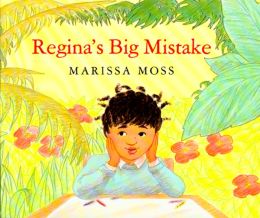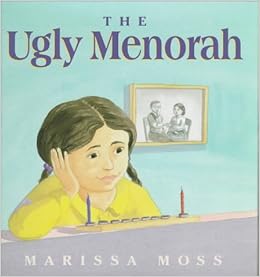
Opening lines: Everyone in Mrs. Li's class got a piece of paper. Everyone was supposed to draw a jungle or a rain forest. That meant Regina too.
Regina is a little girl who struggles with wanting her picture to be perfect -- to follow all the directions and to be as beautiful as everyone else's work. But as she looks around her, she despairs that she will never be able to make a picture as nice as the one's her classmates are making. Then, she starts to make mistakes.
As it turns out, though, the mistakes lead her (as they often do) to make a picture that is different from the ones the other students are making -- in the best possible way. Marissa Moss's simple but realistic drawings make this book an excellent choice for little kids -- but also for high school students who have not yet learned that m making mistakes can lead to some of the best thinking and creativity. So I recommend this one for students in kindergarten through high school (and older if necessary,)
Moss, Marissa (1996) The Ugly Menorah New York: Farrar Straus Giroux.

Opening lines; Rachel loved the heavy silver menorah her family used every Hanukkah. All year long, it sat in the cupboard , hidden from sight, but once a year, at Hanukkah, her father brought it down and polished it and set it in t he window.
Rachel cannot figure out why her grandmother keeps an old ugly menorah on her windowsill, so she asks about it, and her grandmother tells her the story of how Rachel's late grandfather, when they were just married and very poor, made a menorah out of scraps he scavenged from a construction site. Grandma explains that what makes the menorah beautiful is the memories that go with it, and the caring that grandfather put into the object. Rachel comes to understand.
This one is a good book for helping art students to understand that the concept of aesthetic beauty is always subjective. It would work for elementary art, but also might be a good lesson for students in middle school or high school art as well. Moss's illustrations carry a remarkable amount of emotion in them -- though it is hard to pin down exactly how they do that.
Schwartz, David M. (1998) G is for Googol: A Math Alphabet Book Berkeley, CA: Tricycle Press

Opening lines: A is for Abacus. Hundreds of years before calculators were invented, people in China discovered they could add and subtract quickly by sliding beads back and forth on strings.
Actually, though, the explanation of Abacus goes on for two full paragraphs, two cartoon illustrations and an explanation of how an abacus works. That page also has a list of none other math terms that start with A. B is for Binary gets a two page spread, 13 paragraphs, a chart illustrating how to form numbers using binary, and two additional illustrations. My point is that even though this is an alphabet book, it doesn't minimize the concepts it is talking about, but explains complicated concepts fully.
This would be a great book for math readers in about third grade up through high school. It might also be interesting for art students to look at how the illustrator (Marissa Moss again) finds ways to picture complicated abstract concepts. Another good picture book.
No comments:
Post a Comment